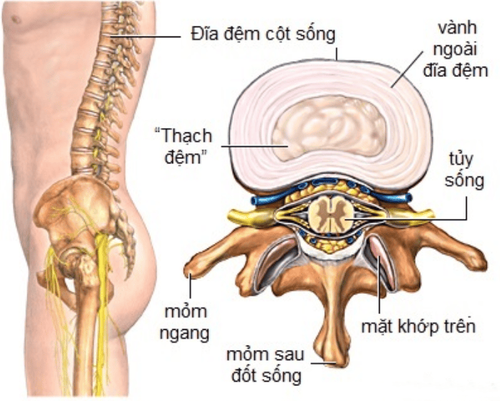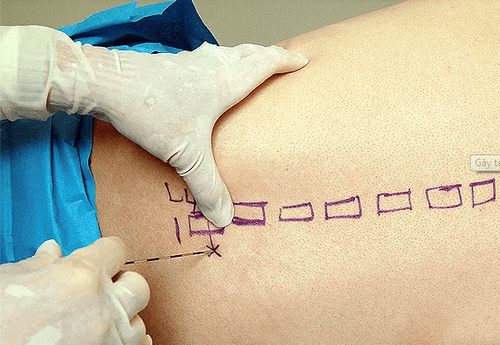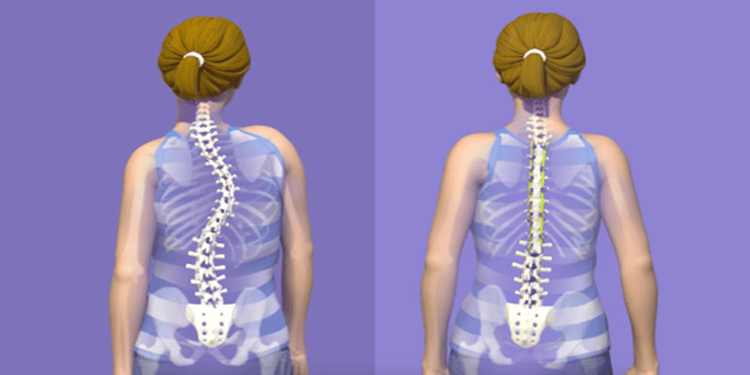This is an automatically translated article.
The article was professionally consulted by Specialist Doctor II Le Minh Viet - Anesthesiologist - General Surgery Department - Vinmec Ha Long International General Hospital.Spinal anesthesia is an anesthetic method for lower abdominal surgery (obstetrics and gynecology, urology...) especially lower extremities orthopedic surgery. This technique is contraindicated for some cases such as spinal deformities, refusal of anesthesia, allergy to anesthetics or some serious diseases.
1. Spinal anatomical features - spine related to spinal anesthesia
The spine consists of 7 cervical vertebrae, 12 thoracic vertebrae, 5 lumbar vertebrae and 5 sacral vertebrae, used as the coccyx. The spine has 4 curved segments with the curvature depending on age, sex, and pathological status. The most curvilinear points of the spine are the easiest to maneuver, so it is easy to insert a needle during anesthesia.Meninges Consists of dura, arachnoid and choroid. The dura mater is the part that covers the entire canal. The arachnoid slides over the outer wall of the dura, with a virtual space between the two membranes. During spinal anesthesia, if only through the dural puncture, not through the arachnoid, but injected with anesthetic, the patient will not have enough pain relief for surgery. The chorionic membrane is the innermost membrane, located close to the nerve organization, the cerebrospinal fluid is located between the choroid and the arachnoid membrane.
Spinal cord The arterial system for the spinal cord is located in the front of the spinal cord, so there are few complications with spinal anesthesia.

Hình ảnh giải phẫu tủy sống - cột sống
The density of the cerebrospinal fluid is related to many techniques. spinal anesthesia with hypertonic or isotonic local anesthetic. Due to the influence of cerebrospinal fluid pressure, when administering spinal anesthesia in the sitting position, it is difficult for the anesthetic to spread to high altitude.
Posterior vertebral spines Lateral spine spines System of ligaments Epidural space
2. What is spinal anesthesia?
Spinal anesthesia is a method of regional anesthesia, performed by the doctor injecting anesthetic into the subarachnoid space. The anesthetic will act to inhibit the conduction of nerve roots. These nerve roots are not covered by the nerve sheath, so they are in direct contact with the anesthetic in the cerebrospinal fluid. The patient will lose sensation from the area below the navel downward.Time for anesthetic to penetrate into nerve organizations occurs quickly, reaching the maximum in about 5 - 10 minutes after injection (depending on the type of anesthetic). Factors that affect the duration of anesthesia include the type of anesthetic, the dose used, the drug has a vasoconstrictor or not.
Spinal anesthesia has many advantages such as less side effects on the respiratory system; patients who can breathe on their own should reduce the risk of aspiration or complications from difficult airways; avoid the risk of hypoglycemia for patients with diabetes; early recovery of bowel movements; reduce the risk of deep vein thrombosis and pulmonary embolism,...

Gây tê tủy sống là một kỹ thuật gây tê vùng bằng cách bơm thuốc tê vào trong dịch não tủy
3. When is spinal anesthesia indicated?
Spinal anesthesia is a technique used to anesthetize the following cases:Orthopedic surgery: Applied to surgery from the pelvis to the lower extremities; Urological surgery: Spinal anesthesia reduces the amount of blood lost and the anesthetic time is enough for the doctor to complete the surgery; Abdominal surgery: Spinal anesthesia for lower abdominal surgery (hernia, appendix, pelvic surgery, anorectal surgery) and some upper abdominal surgery (need to combine spinal anesthesia with general anaesthesia, pay attention to complications of bradycardia, respiratory failure, hypotension); Obstetric and gynecological surgery: Most obstetric and gynecological surgeries can be performed well under spinal anaesthesia, but it is important to pay attention to the complications of hypotension during anesthesia. In addition, the method of continuous epidural anesthesia also promotes very good results; Anesthesia relieves pain.
4. Contraindications to spinal anesthesia
4.2 Relative contraindications No spinal anesthesia (if not indicated) in the following cases:People with aortic valve stenosis; Patients with mitral stenosis; People suffering from malnutrition; People with high blood pressure that have not been treated stably; Anemic patients; People with coronary artery disease or myocardial infarction ; People with back pain; Patients with cerebrovascular fibrosis; Patients with osteoarthritis, cancer metastasis to the bone; People who are suffering from headaches; Children are too young, difficult to do. Spinal anesthesia is a technique with many advantages, widely applied in surgery today. When being assigned to perform spinal anesthesia, the patient should strictly follow the instructions of the specialist.
Vinmec International General Hospital is a high-quality medical facility in Vietnam with a team of highly qualified medical professionals, well-trained, domestic and foreign, and experienced.

Người bị dị dạng cột sống thuộc nhóm đối tượng chống chỉ định tuyệt đối với gây tê tủy sống
People with aortic valve stenosis; Patients with mitral stenosis; People suffering from malnutrition; People with high blood pressure that have not been treated stably; Anemic patients; People with coronary artery disease or myocardial infarction ; People with back pain; Patients with cerebrovascular fibrosis; Patients with osteoarthritis, cancer metastasis to the bone; People who are suffering from headaches; Children are too young, difficult to do. Spinal anesthesia is a technique with many advantages, widely applied in surgery today. When being assigned to perform spinal anesthesia, the patient should strictly follow the instructions of the specialist.
Vinmec International General Hospital is a high-quality medical facility in Vietnam with a team of highly qualified medical professionals, well-trained, domestic and foreign, and experienced.
A system of modern and advanced medical equipment, possessing many of the best machines in the world, helps to detect many difficult and dangerous diseases in a short time, supporting the diagnosis and treatment of effective doctors. most fruitful. The hospital space is designed according to 5-star hotel standards, giving patients comfort, friendliness and peace of mind.
Specialist II Le Minh Viet has more than 30 years of experience in the field of Anesthesia - Resuscitation, including more than 2 years as a Medical expert in Yemen and former Head of Anesthesia - Resuscitation Department - Hospital Thanh Nhan, Hanoi. Currently, Dr. Le Minh Viet is an anesthesiologist, Anesthesia Unit - operating room, Vinmec Ha Long International Hospital.
To register for an examination at Vinmec International General Hospital, you can contact the nationwide Vinmec Health System Hotline, or register online HERE.













